Conditionals Lesson
Yameli Caraza, Mexico
Yameli is an ESL teacher at the Secundaria Tec de Monterrey in Zacatecas, Mexico.

Menu
Introduction
Resources
Activities
Conclusion
The conditionals are topics that sometimes scare students. Learning this topic as ESL students can be difficult because of the different ways it can be used. Now instead of making it more difficult, let’s have fun with it. This will open the mind of the student and will make the subject more interesting.
The first conditional is a structure used for talking about unreal situations. The first conditional has two clauses: an independent one and the dependent one. The clause that has if will be the dependent one, because the if is what converts the clause to dependent. The independent clause is the one that doesn’t need another sentence to be understood, usually this one uses will, going to, can and may.
When you use will with first conditional, it is because you are more certain that the independent clause will happen if the unreal situation comes true. It is the same when you use going to. For example, If I win the lottery, I will travel. If I win the lottery, I’m going to be rich. Meanwhile when you use may with the first conditional, it is because you are not very certain that this will happen if the unreal situation comes true. This is more unlikely to happen. For example: If I win the lottery, I may donate the money. Finally, when you use can with the first conditional, it is because you are the most certain that this clause will come true if the unreal situation happens. For example: if I win the lottery, I can win something.
The second conditional also is a structure used for talking about unreal situations, but in this kind of sentences the dependent clause will be in past. Because of this, the independent clause needs to have different auxiliaries. So we use would, could, and might in the independent clauses.
As in the first conditional, will represents more certainty, in contrast to night that will represent almost not certain. Meanwhile, could represents able to do, but not very certain. For example:
- If I won the lottery, I would buy a house (almost certain).
- If I won the lottery, I might give it away (not certain).
- If I won the lottery, I could pay all my debts (certain but not sure).
Before you teach any conditional your students must know simple future, future with going to, the auxiliary can, in past could, the auxiliary may, in past might, and the auxiliary would.
Hush Little Baby song
I. First conditional
Start with the song HUSH LITTLE BABY.
- Sing the song without the words.
- Now give the incomplete song, the students must place if and the future that is correct.
a. Hush little baby don’t say a word
Papa ___ __________ ___ buy you a mocking bird,
___ that mocking bird doesn’t sing.
Papa ____ _________ ___ buy you a diamond ring,
___ that diamond ring doesn’t shine.
Papa ___ __________ ____ buy you a five and dime,
___ that five and dime goes broke.
Papa ___ __________ ____ buy you a Billy goat,
___ that Billy goat falls down.
You still be the cutest little baby in town.
- Now you can change going to for will.
- Now start giving simple sentences with if like: if I win the lottery or if I am a millionaire. Example:
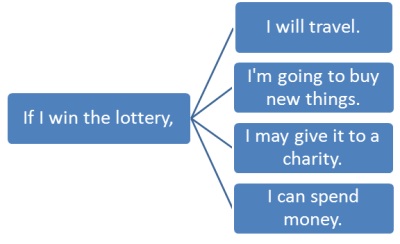
- Tell them to do their own and for a better result, ask them to use imaginary things, like travel to mars, being an alien, etc.
- Now, if there are still some questions, change things around. Start with the independent clause and follow it by the dependent clause.
Example:
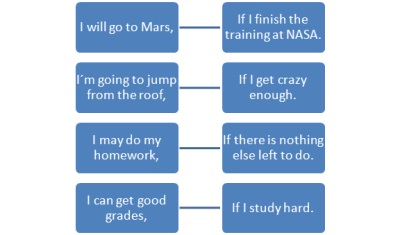
7. Still explain how it is starting with the dependent clause, and that the meaning of the sentence doesn’t change.
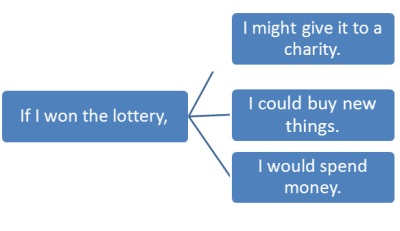
Now, from here it is easier to teach second conditional because is the same structure, but in past.
II. Second conditional
- Turn the Hush Little Baby song to the past.
a. Hush little baby didn’t say a word
Papa was going to buy you a mocking bird,
If that mocking bird didn’t sing.
Papa would buy you a diamond ring….
- Now with the example that you used in first conditional, do it again, but now in past or second conditional.
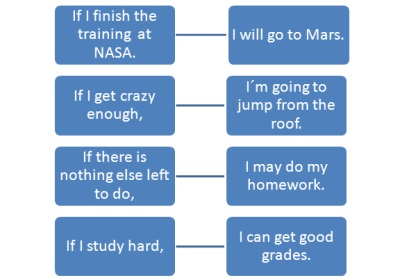
- Tell them to make their own sentences, using the most imaginary things. It is easier to have independent clauses when your dependent clauses sound very crazy and fun.
- As before, if there are some questions put the independent clause in front and the dependent clause following it. Use the same examples, but in the past.
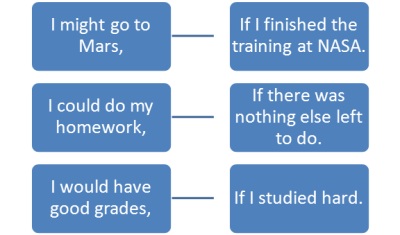
- Now, change things around again so the students can see that is the same sentence and it doesn’t lose the meaning.
As you can see, this subject is easy and fun. But still after I finish, I like to go back to the same “old” teaching and ask the student to make their own sentences 3 or 5 of each.

Please check the Creative Methodology for the Classroom course at Pilgrims website.


|